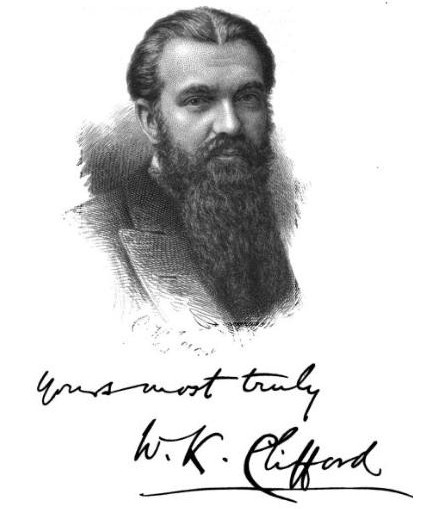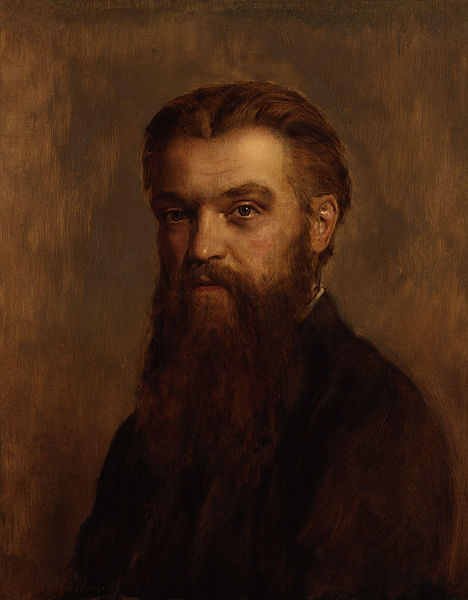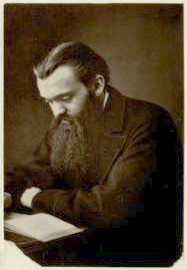<Back to Index>
- Mathematician William Kingdon Clifford, 1845
- Composer Kakarla Tyagabrahmam (Tyāgarāja), 1767
- President of the Republic of China Wang Jingwei, 1883
PAGE SPONSOR



William Kingdon Clifford FRS (4 May 1845 – 3 March 1879) was an English mathematician and philosopher. Building on the work of Hermann Grassmann, he introduced what is now termed geometric algebra, a special case of the Clifford algebra named in his honour, with interesting applications in contemporary mathematical physics and geometry. He was the first to suggest that gravitation might be a manifestation of an underlying geometry. In his philosophical writings he coined the expression "mind - stuff".
Born at Exeter, William Clifford showed great promise at school. He went on to King's College London (at age 15) and Trinity College, Cambridge, where he was elected fellow in 1868, after being second wrangler in 1867 and second Smith's prizeman. Being second was a fate he shared with others who became famous mathematicians. e.g., William Thomson (Lord Kelvin), James Clerk Maxwell. In 1870, he was part of an expedition to Italy to observe an eclipse, and survived a shipwreck along the Sicilian coast.
In 1871, he was appointed professor of mathematics and mechanics at University College London, and in 1874 became a fellow of the Royal Society. He was also a member of the London Mathematical Society and the Metaphysical Society.
On April 7, 1875, Clifford married Lucy Lane. In 1876, Clifford suffered a breakdown, probably brought on by overwork; he taught and administered by day, and wrote by night. A half - year holiday in Algeria and Spain allowed him to resume his duties for 18 months, after which he collapsed again. He went to the island of Madeira to recover, but died there of tuberculosis after a few months, leaving a widow with two children. Eleven days later, Albert Einstein was born, who would go on to develop the geometric theory of gravity that Clifford had suggested nine years earlier.
Similar to Charles Dodgson, he enjoyed entertaining children, writing a collection of fairy stories, The Little People.
Clifford and his wife are buried in London's Highgate Cemetery just north of the grave of Karl Marx, and near the graves of George Eliot and Herbert Spencer.
"Clifford was above all and before all a geometer." (H.J.S. Smith). In this he was an innovator against the excessively analytic tendency of Cambridge mathematicians. Influenced by Riemann and Lobachevsky, Clifford studied non - Euclidean geometry. In 1870, he wrote On the Space - Theory of Matter, arguing that energy and matter are simply different types of curvature of space. These ideas later played a fundamental role in Albert Einstein's general theory of relativity. Yet Clifford is now best remembered for his eponymous Clifford algebras, a type of associative algebra that generalizes the complex numbers and William Rowan Hamilton's quaternions and biquaternions. Clifford employed these to study motion in non - Euclidean spaces and on certain surfaces, now known as Klein - Clifford spaces. He showed that spaces of constant curvature could differ in topological structure. He also proved that a Riemann surface is
topologically equivalent to a box with holes in it. His
contemporaries considered him a man of extraordinary acuteness and
originality, gifted with quickness of thought and speech, a lucid
style, wit and poetic fancy, and a social warmth. In his theory of graphs,
or geometrical representations of algebraic functions, there are
valuable suggestions which have been worked out by others. He was much
interested, too, in universal algebra and elliptic functions, his papers "Preliminary Sketch of Biquaternions" (1873) and "On the Canonical Form and Dissection of a Riemann's Surface" (1877) ranking as classics. Another important paper is his "Classification of Loci" (1878). He published several papers on algebraic forms and projective geometry and the textbook Elements of Dynamic. As
a philosopher, Clifford's name is chiefly associated with two phrases
of his coining, "mind - stuff" and the "tribal self". The former
symbolizes his metaphysical conception, suggested to him by his reading
of Spinoza. Sir Frederick Pollock wrote about Clifford as follows: "Briefly
put, the conception is that mind is the one ultimate reality; not mind
as we know it in the complex forms of conscious feeling and thought,
but the simpler elements out of which thought and feeling are built up.
The hypothetical ultimate element of mind, or atom of
mind - stuff, precisely corresponds to the hypothetical atom of matter,
being the ultimate fact of which the material atom is the phenomenon.
Matter and the sensible universe are the relations between particular
organisms, that is, mind organized into consciousness, and the rest of the world. This leads to results which would in a loose and popular sense be called materialist. But the theory must, as a metaphysical theory, be reckoned on the idealist side. To speak technically, it is an idealist monism." Clifford himself defined "mind - stuff" as follows (1878, "On the Nature of Things - in - Themselves," Mind, Vol. 3, No. 9, pp. 57 – 67): "That
element of which, as we have seen, even the simplest feeling is a
complex, I shall call Mind - stuff. A moving molecule of inorganic matter
does not possess mind or consciousness; but it possesses a small
piece of mind - stuff. When molecules are so combined together as to form
the film on the under side of a jelly - fish, the elements of mind - stuff
which go along with them are so combined as to form the faint
beginnings of Sentience. When the molecules are so combined as to form
the brain and nervous system of a vertebrate, the corresponding elements of mind - stuff are so combined as to form some kind of
consciousness; that is to say, changes in the complex which take
place at the same time get so linked together that the repetition of
one implies the repetition of the other. When matter takes the complex
form of a living human brain, the corresponding mind - stuff takes the
form of a human consciousness, having intelligence and volition." The
other phrase, "tribal self," gives the key to Clifford's ethical view,
which explains conscience and the moral law by the development in each
individual of a "self," which prescribes the conduct conducive to the
welfare of the "tribe." Much of Clifford's contemporary prominence was
due to his attitude toward religion.
Animated by an intense love of his conception of truth and devotion to
public duty, he waged war on such ecclesiastical systems as seemed to
him to favour obscurantism, and to put the claims of sect above those of human society. The alarm was greater, as theology was still unreconciled with Darwinism; and Clifford was regarded as a dangerous champion of the antispiritual
tendencies then imputed to modern science. There has also been debate
on the extent to which Clifford’s doctrine of ‘concomitance’ or
‘psychophysical parallelism’ influenced John Hughlings Jackson’s model of the nervous system and through him the work of Janet, Freud, Ribot, and Ey. For
arguing that it was immoral to believe things for which one lacks
evidence, in his 1877 essay "The Ethics of Belief", which contains the
famous principle: "it is wrong always, everywhere, and for anyone, to
believe anything upon insufficient evidence." As such, he was arguing
in direct opposition to religious thinkers for whom "blind faith" (i.e.
belief in things in spite of the lack of evidence for them) was a
virtue. This paper was famously attacked by pragmatist philosopher William James in his "Will to Believe" lecture. Often these two works are read and published together as touchstones for the debate over evidentialism, faith, and overbelief. Though Clifford never constructed a full theory of spacetime and relativity, there are some remarkable observations he made in print that foreshadowed these modern concepts: This passage makes reference to biquaternions, though Clifford made these into split - biquaternions as his independent development. The book continues with a chapter "On the bending of space", the substance of general relativity. Clifford also discussed his views in On the Space - Theory of Matter in 1876. Clifford's anticipation of Einstein has been frequently noted: In 1923 Hermann Weyl mentioned Clifford as one of those who, like Bernhard Riemann, anticipated the geometric ideas of relativity. In 1940 Eric Temple Bell published his The Development of Mathematics. There on pages 359 and 360 he discusses the prescience of Clifford on relativity: Also in 1960, at Stanford University for the International Congress for Logic, Methodology, and Philosophy of Science, John Archibald Wheeler introduced his geometrodynamics formulation of general relativity by crediting Clifford as the initiator. In his The Natural Philosophy of Time (1961, 1980) Gerald James Whitrow recalls Clifford's prescience by quoting him to describe the Friedmann - Lemaitre - Robertson - Walker metric in cosmology. In 1970 Cornelius Lanczos summarizes Clifford's premonitions this way: In 1990 Ruth Farwell and
Christopher Knee examined the record on acknowledgement of Clifford's
foresight. They conclude "it was Clifford, not Riemann, who anticipated
some of the conceptual ideas of General Relativity". To explain the
backward attitude to Clifford, they point out that he was an expert in
metric geometry, and "metric geometry was too challenging to orthodox epistemology to be pursued." In 1992 Farwell and Knee continued their study with "The Geometric Challenge of Riemann and Clifford" They
"hold that once tensors had been used in the theory of general
relativity, the framework existed in which a geometrical perspective in
physics could be developed and allowed the challenging geometrical
conceptions of Riemann and Clifford to be rediscovered."